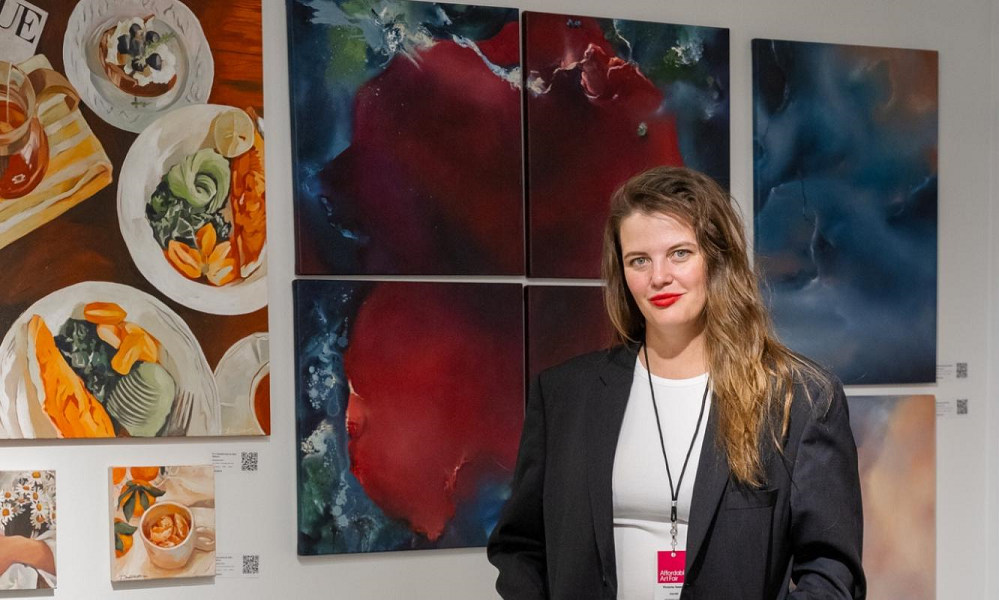The Affordable Art Fair in New York has long been a highlight of the international cultural calendar, drawing more than twenty thousand visitors each year. Collectors, critics, curators, and casual art lovers converge in the heart of Manhattan to see new names, discover emerging trends, and meet the institutions shaping the global art market. This September, however, one story stood out: the appearance of Victoria VICTO Isaeva, a Russian-born artist and the founder of ArtSeeker Gallery, whose participation not only introduced new voices but also reframed the dialogue around gender, identity, and cultural heritage in the arts.
Isaeva’s path is one of determination and transformation. She began her career in Russia, taking part in exhibitions that helped her shape her own artistic language and identity. Her early work reflected both the weight of tradition and the struggle for self-expression in a cultural environment often skeptical toward young female voices. Yet ambition and a profound desire for broader horizons soon led her to New York — a city that thrives on reinvention.
In Brooklyn, she founded ArtSeeker Gallery, which quickly became more than just a commercial gallery. For Isaeva, it is a platform for dialogue, a space where immigrant voices — particularly Russian-speaking women — can take their place on the international stage. ArtSeeker focuses on women artists, amplifying their stories, their struggles, and their visions. The gallery embodies a feminist mission: to break through systemic barriers in the art world and create visibility for those who have historically been overlooked.
“It is a great honor for us to participate in a fair of this level,” says Victoria Isaeva. “Affordable Art Fair is where audiences, collectors, and critics discover new names. Our mission is to show that the art of Russian-speaking artists — especially women — deserves to be seen alongside global trends.”
Her presence at the Affordable Art Fair New York in September 2025 was both symbolic and substantive. Symbolic, because it represented the journey from Russia to Manhattan — a leap not just of geography but of recognition. Substantive, because the booth of ArtSeeker Gallery became one of the most talked-about spaces at the fair. Visitors lingered, engaging with the works and with the stories behind them. Many remarked on the unique energy of the exhibition, which combined the cultural sensibilities of the Russian-speaking diaspora with the urgency of feminist narratives.
Isaeva herself became a focal point of attention. Critics noted that she embodies a dual role: both as an artist whose work explores themes of identity, exile, and resilience, and as a curator advocating for a community of women artists. This dual perspective gives her gallery authenticity — a deep understanding of the creative process combined with the strategic vision to bring overlooked voices to the forefront.
Her story, however, is not only about professional success. It reflects a broader feminist history: the persistent effort of women to create spaces for themselves in industries that remain male-dominated. For decades, women artists were marginalized, relegated to footnotes in art history, while their male counterparts were canonized. By explicitly building ArtSeeker Gallery as a women-centered institution, Isaeva positions herself within this longer lineage of feminist struggle, adding her own voice to the ongoing demand for equality and visibility.
The Affordable Art Fair, with its twenty-plus years of history and reputation for launching careers, became the perfect stage for this message. Each year the fair welcomes over 20,000 attendees, ranging from seasoned collectors to first-time buyers. For many, the discovery of ArtSeeker Gallery was a revelation: here was a space where immigrant women’s art did not stand in the shadow of larger institutions but demanded attention on its own terms.
Isaeva’s personal journey adds resonance to this narrative. Having left Russia, she carried with her both the artistic traditions of her homeland and the desire to confront and challenge them. From the struggles of her first exhibitions to the triumph of standing in Manhattan’s Metropolitan Pavilion, her path illustrates the possibility of overcoming national borders, cultural stereotypes, and gender expectations.
Observers suggest that Isaeva is on the cusp of becoming a major figure in New York’s art scene. Not only is she curating a gallery that speaks to the immigrant experience, but she is also forging a distinctly feminist voice. In a city where cultural capital often determines success, her ability to weave together personal narrative, artistic innovation, and collective advocacy positions her as one of the most compelling new presences of 2025.
The impact of her participation is likely to extend beyond this single event. Media interest — including interviews filmed by RTVI directly from the fair — has already amplified her story. Collectors who encountered ArtSeeker Gallery for the first time expressed interest in following future exhibitions. Critics praised the boldness of highlighting women artists from the Russian-speaking diaspora at such a prestigious international forum.
For Victoria Isaeva, however, the journey is far from complete. As she herself emphasizes, Affordable Art Fair is not an endpoint but a beginning — the start of a new chapter where ArtSeeker Gallery continues to advocate for women’s voices, immigrant narratives, and artistic experimentation.
From Russia to Manhattan, her story resonates as both personal triumph and collective breakthrough. In Isaeva’s words and actions, one finds the essence of what feminist art history has long fought for: recognition, equality, and the right to be seen and heard. And in the bustling, competitive environment of New York’s art world, that is no small achievement.
As the lights dimmed on the Affordable Art Fair 2025, one fact was clear: Victoria Isaeva had not only introduced her gallery and her artists to the world, she had also carved out a place for herself in the evolving story of global contemporary art. Her journey underscores that art is not only about canvases and installations but about creating spaces — spaces where the silenced speak, where the overlooked are illuminated, and where women, finally, stand at the center of the narrative.

